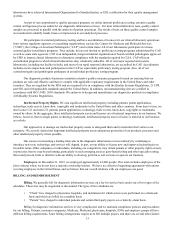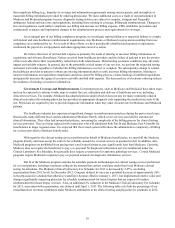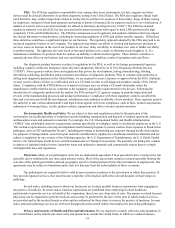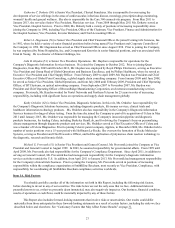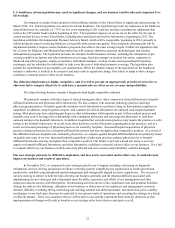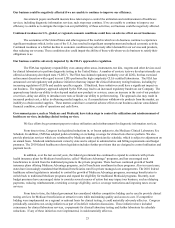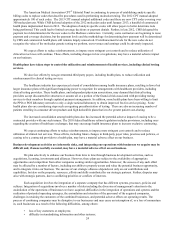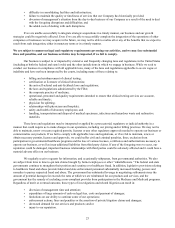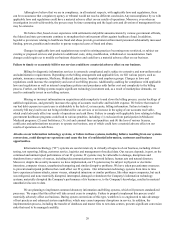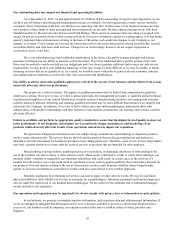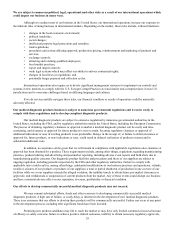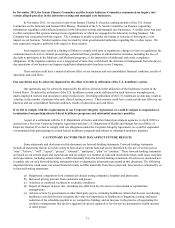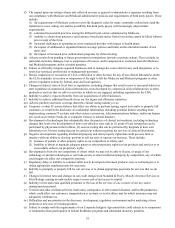Quest Diagnostics 2012 Annual Report Download - page 25
Download and view the complete annual report
Please find page 25 of the 2012 Quest Diagnostics annual report below. You can navigate through the pages in the report by either clicking on the pages listed below, or by using the keyword search tool below to find specific information within the annual report.22
U.S. healthcare reform legislation may result in significant changes, and our business could be adversely impacted if we
fail to adapt.
Government oversight of and attention to the healthcare industry in the United States is significant and increasing. In
March 2010, U.S. federal legislation was enacted to reform healthcare. The legislation provides for reductions in the Medicare
clinical laboratory fee schedule of 1.75% for five years beginning in 2011 and also includes a productivity adjustment that
reduces the CPI market basket update beginning in 2011. The legislation imposes an excise tax on the seller for the sale of
certain medical devices in the United States, including those purchased and used by laboratories, beginning in 2013. The
legislation establishes the Independent Payment Advisory Board, which will be responsible, beginning in 2014, annually to
submit proposals aimed at reducing Medicare cost growth while preserving quality. These proposals automatically will be
implemented unless Congress enacts alternative proposals that achieve the same savings targets. Further, the legislation calls
for a Center for Medicare and Medicaid Innovation that will examine alternative payment methodologies and conduct
demonstration programs. The legislation provides for extensive health insurance reforms, including the elimination of pre-
existing condition exclusions and other limitations on coverage, fixed percentages on medical loss ratios, expansion in
Medicaid and other programs, employer mandates, individual mandates, creation of state and regional health insurance
exchanges, and tax subsidies for individuals to help cover the cost of individual insurance coverage. The legislation also
permits the establishment of accountable care organizations. While the ultimate impact of the legislation on the healthcare
industry is unknown, it is likely to be extensive and may result in significant change. Our failure to adapt to these changes
could have a material adverse effect on our business.
The clinical testing business is highly competitive, and if we fail to provide an appropriately priced level of service or
otherwise fail to compete effectively it could have a material adverse effect on our revenues and profitability.
The clinical testing business remains a fragmented and highly competitive industry.
We primarily compete with three types of clinical testing providers: other commercial clinical laboratories, hospital-
affiliated laboratories and physician-office laboratories. We also compete with anatomic pathology practices and large
physician group practices. Hospitals generally maintain on-site laboratories to perform testing on their patients (inpatient or
outpatient). In addition, many hospitals compete with commercial clinical laboratories for outreach (non-hospital patients)
testing. Most physicians have admitting privileges or other relationships with hospitals as part of their medical practice and
hospitals may seek to leverage their relationships with community physicians and encourage the physicians to send their
outreach testing to the hospital's laboratory. In addition, hospitals that own physician practices may require the practices to refer
testing to the hospital's laboratory. In recent years, there has been a trend of hospitals acquiring physician practices, and as a
result, an increased percentage of physician practices are owned by hospitals. Increased hospital acquisitions of physician
practices enhance physician ties to hospital-affiliated laboratories and may strengthen their competitive position. As a result of
this affiliation between hospitals and community physicians, we compete against hospital-affiliated laboratories primarily based
on quality and scope of service. Increased hospital acquisitions of physician practices enhance physician ties to hospital-
affiliated laboratories and may strengthen their competitive position. Our failure to provide a broad test menu or services
superior to hospital-affiliated laboratories and other laboratories could have a material adverse effect on our business. If we fail
to compete effectively, our business could be adversely affected and our revenues and profitability could be damaged.
Our new strategic plan may be difficult to implement, and may not be successful, and in either case, it could adversely
impact our business and results of operations.
In November 2012, we announced a new strategic plan for our Company, including: refocusing on diagnostic
information services; driving operational excellence; restoring growth; simplifying our organization to enable growth and
productivity; and delivering disciplined capital management and strategically aligned accretive acquisitions. The success of
our new strategy is subject to both the risks affecting our business generally and the inherent difficulty associated with
implementing our new strategies and is dependent upon the skills, experience and efforts of our management and other
employees and our success with third parties. Restructuring activities involve risks, significant costs and potential liabilities.
Among the risks are the following: disruption of our business or distraction of our employees and management; customer
attrition; difficulty recruiting, hiring, motivating and retaining talented and skilled personnel; increased stock price volatility
and changes to our stock price that may be unrelated to our current results of operations; and executing the strategy in a timely
or efficient manner. There is no assurance that we will be able to successfully implement these strategic initiatives or that
implementation of changes will result in benefits or cost savings at the levels that we anticipate or at all.





